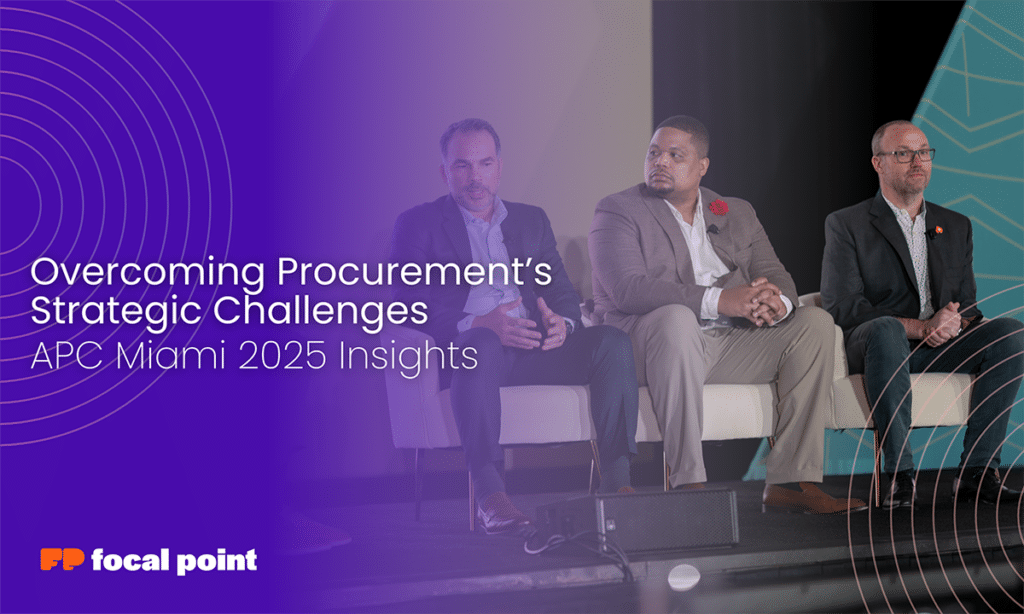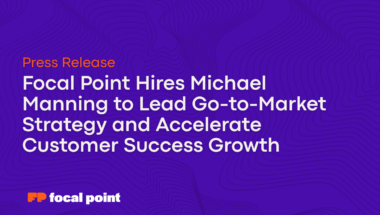Procurement is evolving rapidly, and many enterprise organizations still struggle with outdated processes, fragmented technology, and misaligned stakeholder expectations as they evolve. At Procurement Leaders’ America Procurement Congress 2025 in Miami, a panel of industry leaders, including Focal Point Founder and CEO Anders Lillevik discussed these challenges and explored strategies for overcoming them while driving procurement transformation.
Accompanying Anders Lillevik were Javier Castro, SVP & Global Head of Strategic Sourcing at Blackstone, and Dr. Sy Henderson, Head of Americas Procurement at Bacardi. Moderated by Jim Callahan, Senior Executive Advisor at Procurement Leaders, the discussion focused on how procurement teams can enhance visibility, define their strategic value, and leverage next-generation tools like AI.
Key Challenges in Procurement Today
One of the biggest hurdles procurement leaders face is gaining clear visibility into company-wide spending. As Henderson explained, “Our biggest opportunity is helping stakeholders truly understand what they’re spending. Visibility into data—especially in a way that allows collaboration with finance and budget owners—helps build trust and strengthens procurement’s role in strategic decision-making.” Without this transparency, procurement struggles to prove its value and align with business priorities.
Beyond cost savings, procurement plays a vital role in enabling business strategy, managing risk, and driving efficiency. Castro shared that at Blackstone, procurement is expected to go beyond traditional cost-cutting and actively contribute to investment success. “For us, it’s about leveraging procurement to enable our investment teams to deliver returns. The challenge is defining exactly where procurement creates value and ensuring that’s understood across the organization,” he said.
Many organizations are still at the early stages of procurement digitalization. Both Castro and Henderson highlighted the need to optimize existing technology and close skill gaps before introducing new tools. “If we don’t put the dedicated team in place and start making tangible progress, we risk looking up in six to nine months and realizing we’re still just talking about transformation instead of actually doing it,” said Henderson.
How Procurement Leaders Are Tackling These Challenges
Procurement leaders recognize that success requires alignment between people, process, and technology. Castro emphasized the importance of making procurement operations intuitive for both internal teams and external stakeholders. “One of our biggest challenges is wayfinding—stakeholders often don’t know where to go in procurement. Do they go to sourcing? Do they go to risk? Do they need contract management? Clarifying these processes and eliminating unnecessary friction is key,” he explained.
Henderson stressed the need to make steady progress instead of overanalyzing transformation efforts—momentum is key to building buy-in. “I’ve been through digital transformations at multiple companies, and what I’ve learned is that you can get so focused on building the perfect business case that you never actually make progress. At some point, you have to move forward and show results,” he said.
Lillevik also pointed out that procurement transformations are never truly “done” because the landscape is always shifting. “Unlike accounting, where processes have been established for decades, procurement is constantly being asked to take on new challenges—ESG, risk management, diversity initiatives. The goalposts keep moving, so procurement has to keep evolving,” he noted.
AI & Next-Gen Tools: Hype vs. Reality
Artificial intelligence (AI) has been a major topic of discussion in procurement, but leaders are approaching it with caution. The panel members emphasized that AI should enable decision-making rather than replace critical thinking.
“AI is an enabler, but it doesn’t fix broken systems. If your processes and data aren’t solid, AI will just expose those gaps even more,” Castro warned.
He also shared that Blackstone is leveraging AI for deal analysis and refining business case narratives, using it to complement rather than take over key strategic functions. “We’re using AI in a very tactical way—analyzing economic trends in our deals, refining the clarity of our business cases, and even conducting post-mortems on sourcing events to extract key learnings,” he said.
Lillevik agreed, warning that layering AI on top of broken processes only amplifies inefficiencies. “If your procurement function lacks maturity, AI isn’t going to save you—it’s just going to create more noise. You have to get the fundamentals right before introducing advanced technology,” he cautioned.
Winning Buy-In for Tech Investments
Demonstrating ROI is critical for securing investment in procurement technology. Henderson emphasized that securing early successes helps establish credibility, making it easier to gain support for larger initiatives. “You have to prove that when the business gives you a dollar, you maximize that dollar. Getting small wins and showing tangible ROI helps build the case for bigger investments,” he explained.
Lillevik advised that procurement teams can use past disruptions, such as supply chain failures or fraud incidents, as compelling reasons to push for better tools. “Never let a bad event go to waste. If you’ve experienced a compliance failure or a disruption in your supply chain, use that as leverage to show why better technology is needed,” he said.
Castro noted that ROI isn’t always measured in direct cost savings. Improvements in operational efficiency, user experience, and risk mitigation can be just as valuable as financial returns.
Final Takeaways
The panelists agreed that procurement transformation is an ongoing journey, requiring a balance of people, process, and technology. Transparency and visibility are essential for building trust with stakeholders, making procurement a more strategic function within an organization. AI and other next-generation tools offer significant potential, but they must be implemented thoughtfully and in alignment with existing processes.
Procurement’s role extends far beyond savings—it includes risk management, operational efficiency, and business enablement. Leaders must take an agile approach, ensuring they make consistent progress rather than waiting for the perfect transformation plan.
Lillevik summed it up with a key piece of advice: “Figuring out the art of the possible is one of the biggest challenges in procurement today. Many teams focus on fixing what’s broken instead of envisioning what’s next. If you only focus on current inefficiencies, you’ll never build something truly transformative.”
Conclusion
As procurement continues to evolve, organizations must rethink their approach to technology, stakeholder engagement, and strategic value. The key isn’t just adopting new tools—it’s ensuring they align with the right processes and objectives.
At Focal Point, we help organizations streamline procurement operations with procurement orchestration software that enables visibility, efficiency, and seamless stakeholder collaboration.
Want to learn more? Connect with us to see how procurement orchestration can help you optimize your procurement strategy.



